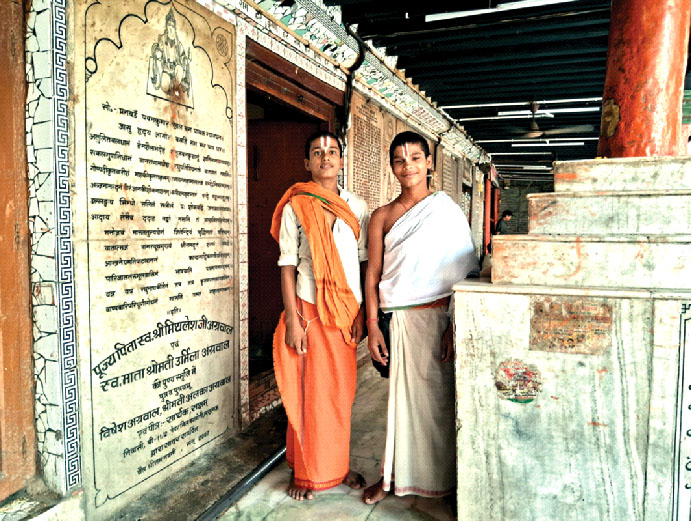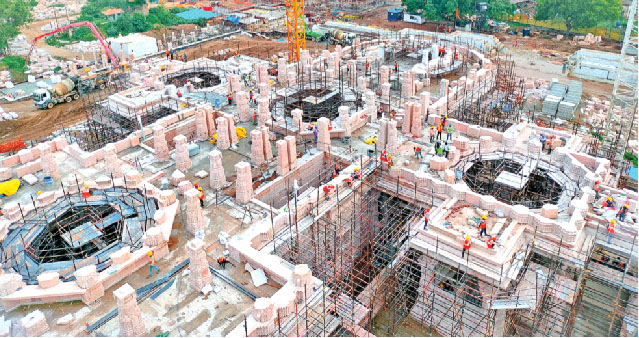It was yet another day of the monsoon with a slight drizzle in the evening in the holy city of Ayodhya, where a happy chaos was prevailing in most of the parts. The Ayodhya-Faizabad road adjoining the historical Hanuman Gadhi temple was still the centre of attraction as despite its pre-built state it was the only interlinking route to connect most of the historical sites including one of the sacred sites for the Hindus for which the majoritarian community was fighting for centuries.
In the chaotic atmosphere prevailed a sense of joy, fulfillness not only in those who have arrived here for a glimpse of the idol of Bhagwan Ram before its manifestation into the grand temple being erected in the western corner of the city but also within those who were living here for centuries. Hours later, when the tiny small corners of the town lit up, the prevailing sound of Bhajans (a Hindu ritual to pray before Bhagwan) was soothing to ears. Few meters away from the interlinking road lies the Maniram Chhawani, a centre for gathering for the Karsevaks in the Ayodhya movement of the 1990s where hundreds of ‘sadhus’ were singing and dancing to the tunes of bhajans. Sitting in the front row on a chair is Nritya Gopal Das Maharaj, chief of the Ayodhya’s largest Chhawani and Chairman of Shri Ram Janmabhoomi Teerth Kshetra trust, a fifteen member body presiding over the construction of Ram Temple. A close look on his face can tell you the calm and peace he is having after years of struggle for the holy land for Hindus.

Upon enquiring, Jankinath ji, a sewadar of Nritya Gopal Das Maharaj, said that Maharaj ji has lived to its fullest and now he has detached himself from everything to devote his rest of the time in the feet of Bhagwan Ram. Though Gopal Das is not alone who has chosen this path, there are hundreds of thousands of saints who you can trace in every nook and corner of the city, residing here in their pursuit for salvation in the holy city once ruled by King Ram himself.
Puja at Venerated Site
A kilometer and a half away on the main road, thousands of devotees walk upon to reach the banks of holy Saryu where they would spend their night. Most devotees were from the nearby region who had arrived in Ayodhya to pray before the idol, standing in a makeshift temple meters away from the holy site where Ram is believed to be incarnated. An hour after the sunset, a section of these devotees gathered near the young priests performing Aarti to the holy river (a Hindu ritual showing respect towards the river) Saryu at Ram Ghat. The sight was mesmerising; so were the chants of devotees which were reverberating through Ram Ghat.
Shared Heritage
Standing next to the Ghat is Queen Koo Park, being built-up by the South Korean and the Indian Government in memory of the legendary Korean queen Heo Hwang-ok alias Suriratna. On the adjoining main road, thousands of people hailing from different parts of the country can be seen arriving and departing. The process continues intermittently for the rest of the night while the holy city falls asleep in the soothing breeze of Saryu.
The next morning on a bright sunny day, the crowd at the interlinking road adjoining Hanuman Garhi was much at ease while walking upon as the mud on the roads was soaked up in the sunlight. There were barricades everywhere indicating constructions of roads and other public facilities. Additionally, buildings on both sides of the roads were partially bulldozed to make the roads wider while vehicles have been barred from entering certain narrow stretches to avoid obstruction in the progress of work.
Remembering Kar Sevaks
Around 700 metres from the interlinking road at VHP karyashala, hundreds of devotees arrive daily to get a glimpse of the engraved rocks for the temple. Here, the engraving work has been going on for decades. On the right hand corner, stands a picture hall dedicated to the centuries old struggle for the temple which also holds a portrait of Kothari brothers, who got martyred in the Ram Janmabhoomi movement. Five hundred metres away from the Karsevak Puram sculpture, work is in full swing in another Karyashala, where Shaligrams rocks brought from Nepal and other places were stationed. There are hundreds of sculptures, some are open to display while a few enclosed and strictly guarded whose gates are open only twice a day that too for reciting mantras/slokas before and end of the day’s proceeding.
Swell in Numbers of Devotees
Back on the interlinking road, there are thousands on the streets making their way to the famous Hanuman Garhi shrine, standing tall at the heart of the city where thousands made their way to offer prayers before the Sankatmochan. The 100 meters stretch, on either side of Rajdwar, is always filled with devotees. A significant number among them can be seen halting and praying in the temple premises as well.

Inside the temple is Raju Ram Das, a sewak of the temple, who has been living in the temple premises for decades while sitting on the veranda on the northern side of the temple. He informed, earlier the number of devotees used to be less, though nowadays their number have gone exponentially. There is a positive change in the atmosphere as well. When enquired about who do you want to thank for all this, he replied, politics aside, Yogi ji comes here very often, “I would not say any political party or politician is bad or good but yes it’s all unfolding before our eyes while Narendra Modi ji is our Prime Minister, so we should all thank him”, he said.
Elucidating Bharatiya Knowledge System
Standing behind Raju Ram Das were two young children in their adolescence, Gaurav Pathak and Kamal Nath Pandey, both residents of Ayodhya. Their attire appears to be no less organised than that of the monks, who are between 40 and 50 years of age. Upon enquiring about what they learn here, they informed that they study ‘Yajurveda’, one of the four ‘Vedas’ considered sacred for Hindus. There are hundreds of thousands like Gaurav and Kamalnath, while some study with them in the temple premises, others in separate institutions (Gurukul) located in different corners of the city with a sole aim to learn and teach the ancient stream of ‘Bharatiya knowledge system’ to the upcoming generations.
Around 300 meters away from the historical Hanuman Garhi, there were another hundreds in the queue waiting for their turn for a glimpse of the Ramlala on the western corner of the city. Of those some arrived from the nearby regions, while others came from as far as Andhra Pradesh yet chanting similar slogans and bhajans on their way to the makeshift temple through the enclosed gallery.
On the left hand side of the gallery lies the remains of the 15th century temple, unearthed by the Archaeological Survey of India (ASI) during the excavation of the site. Those who were passing from the gallery could also be seen folding their hands before the grand structure being erected in the right hand side, where Pran Pratishtha of Ramlala is scheduled to be held in January next year.
There were overwhelming emotions for some, while some stood apart from the queue staring at the splendid structure and the remains of the ancient temple. Those who walked out after the Darshan had a common disbelief about the injustice done to the community yet an overwhelming satisfaction of a grand temple coming up even after the struggle of centuries in which lakhs of Hindus perished fighting for the cause of their beloved Bhagwan Ram.
Hours later when a mesmerising evening gripped the holy town, Organiser representative also met Shobhit Tiwari, an auto driver in his early 30s. Tiwari who resides on the northern corner of the city informed, that we have been brought up listening to the stories of bloodbath in Ayodhya and of the Karsevaks struggle for the temple.
Those were scary times when our father used to tell us about the sensitivity of living in Ayodhya, we were told that every narrow stretch of the town was filled with blood of Karsevaks in the 1990s movement. The narrow road passing from the Maniram Chhawani to Hanuman Garhi is still called the ‘martyred path’; the Karsevaks sacrificed their lives for Bhagwan Ram and his temple, said Tiwari.
However, things have changed now, there is a sense of joy within those who came here for Darshan as well as the locals, their long cherished dream is about to come true. There is a major overhaul of Ayodhya as well, the Chief Minister himself visits the town once every two months, now it seems like the ancient glory and pride of Ayodhya about which we had heard from our forefathers, is being rejuvenated. We consider ourselves fortunate to be a witness of all these, said an elated Tiwari on a tea stall near the banks of Saryu.
More or less that is what can be heard on every nook and corner of the city. In all Ayodhya, a city with its roots back to Treta Yug (first among the four yug according to the Hindu calculation of time) has been preparing for the manifestation of the grand temple for their beloved King Ram, who after millions of years is still worshiped and celebrated by crores of Sanatani Hindus across the world. Though in its pursuit for the temple it seems as if the whole city has donned the colours of Vedic culture, seen evidently on the streets of Ayodhya. Undoubtedly, this is nothing but a new dawn for Sanatan , rising in the sacred land of Rama where the whole city is on its toes awaiting the divine light of righteousness to shine forth from the newly built temple of their beloved King Ram.




















Comments